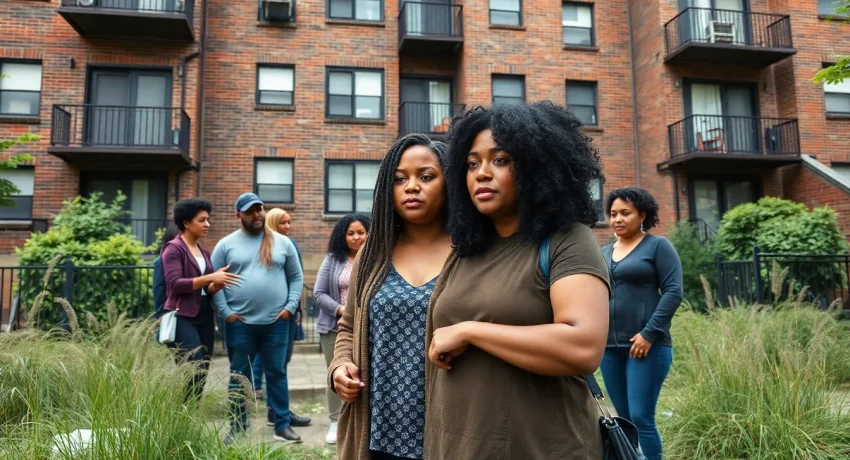Table of Contents
ToggleIn today’s rental market, tenant living conditions have become a hot topic of discussion. With rising rent prices and increasing demand for affordable housing, many tenants find themselves navigating a complex landscape that directly impacts their quality of life. Understanding these living conditions is essential, as they can significantly influence mental health, financial stability, and overall well-being.
From inadequate maintenance to safety concerns, the experiences of tenants vary widely. Some enjoy comfortable and well-managed spaces, while others face numerous challenges that can lead to frustration and distress. This article delves into the key factors affecting tenant living conditions, highlighting the importance of fostering safe and supportive environments for all renters.
Overview of Tenant Living Conditions
Tenant living conditions significantly impact overall quality of life. Factors such as rent prices, maintenance quality, and safety measures contribute to the experiences of renters.
Rent Prices
Rent prices continue to rise, making it difficult for many to find affordable housing. In urban areas, a decline in available rental units and increased demand exacerbates this issue. For instance, average rent in major cities can exceed $2,500 monthly, placing stress on financial budgets.
Maintenance Quality
Maintenance quality varies widely among rental properties. Some landlords prioritize upkeep, ensuring that facilities remain functional and attractive. Others neglect essential repairs, leading to issues like plumbing failures and poor heating systems. Many tenants report delayed responses to maintenance requests, which can worsen living conditions.
Safety Measures
Safety measures play a crucial role in tenant satisfaction. Properties with secure entry systems, adequate lighting, and well-maintained common areas foster a sense of security. Conversely, buildings lacking these features often experience higher crime rates, negatively affecting residents’ peace of mind.
Mental Health and Well-Being
Tenant living conditions also influence mental health and well-being. Environments with inadequate upkeep or safety concerns can lead to increased stress and anxiety. Research indicates that individuals living in poorly maintained homes experience negative health outcomes, further highlighting the need for improved living situations.
Community Support
Community support enhances tenant living conditions by providing resources and fostering connections. Access to local services, tenant associations, and support networks enables renters to voice concerns and advocate for improved housing standards. Strong community ties can lead to collaborative efforts to address common issues.
Conclusion
Understanding tenant living conditions involves examining multiple factors that impact the rental experience. By addressing issues related to rent prices, maintenance quality, safety measures, and mental health, stakeholders can work to create improved living environments for all renters.
Factors Influencing Tenant Living Conditions

Several factors play a crucial role in shaping tenant living conditions, impacting overall quality of life for renters. These elements include location and environment as well as property management practices.
Location and Environment
Location significantly affects tenant living conditions. Proximity to essential services, such as grocery stores, schools, and public transportation, enhances convenience and accessibility. Urban areas, while often more expensive, may offer better job opportunities and amenities but can also contribute to higher stress levels due to noise and congestion. Environmental features, including green spaces and cleanliness, also influence tenants’ satisfaction with their homes. Properties situated in safe neighborhoods typically enjoy higher demand and better living conditions, fostering a sense of community among residents.
Property Management Practices
Property management practices directly impact the state of rental units. Responsiveness to maintenance requests reflects a landlord’s commitment to tenant well-being. Timely repairs and regular property upkeep create more comfortable living conditions, while neglect can lead to health hazards like mold or pest infestations. Transparent communication between tenants and property managers facilitates a collaborative environment. Moreover, effective management ensures compliance with local housing regulations, enhancing safety measures, such as smoke detectors and secure entry systems. These practices contribute to tenant retention and overall community stability.
Common Issues Faced by Tenants
Tenants frequently encounter a variety of challenges that adversely affect their living conditions. Common issues often stem from maintenance problems and safety concerns.
Maintenance and Repairs
Maintenance quality remains a significant issue for many tenants. Some landlords promptly address repair requests, while others postpone or ignore them, leading to deteriorating living conditions. Common maintenance problems include plumbing leaks, malfunctioning heating or cooling systems, and broken appliances. According to a survey by the American Housing Survey, over 23% of renters reported issues requiring urgent repairs in their homes. Tenants must document these requests and, if necessary, follow up to ensure timely resolutions.
Safety and Security Concerns
Safety is crucial for tenants’ peace of mind. Issues often arise regarding inadequate security measures, such as poorly lit hallways, broken locks, or insufficient surveillance systems. A 2022 study by the National Low Income Housing Coalition indicated that properties lacking safety features often experience increased crime rates, impacting tenant satisfaction. Effective safety measures, like secure entry systems and functioning intercoms, enhance residents’ sense of security.
Addressing maintenance and safety concerns significantly improves tenant living conditions and overall well-being.
Importance of Tenant Rights
Tenant rights play a critical role in ensuring safe, secure, and dignified living conditions. These rights empower individuals to seek redress against unfair practices and promote community well-being.
Legal Frameworks
Legal frameworks establish the foundation for tenant rights, promoting fair treatment and safety standards. Various local, state, and federal laws govern landlord-tenant relationships. For instance, the Fair Housing Act prohibits discrimination based on race, color, national origin, religion, sex, familial status, or disability. This law protects tenants from unjust evictions and unsafe living conditions. Additionally, local housing codes set minimum standards for maintenance and safety, ensuring landlords fulfill their obligations. California’s Tenant Protection Act, for example, limits rent increases and provides eviction protections. Understanding these laws helps tenants identify their rights, which can encourage better living conditions and reduce exploitation.
Advocacy and Support Resources
Advocacy and support resources empower tenants to navigate challenges effectively. Numerous organizations provide assistance, such as local tenant unions and housing advocacy groups. These entities offer resources like legal advice, tenant education, and support in disputes with landlords. The National Low Income Housing Coalition is a prominent example, advocating for affordable housing policies. Additionally, online platforms like Renters United connect tenants with local support groups to address grievances. Engaging in these resources equips tenants with knowledge and fosters community solidarity, ultimately enhancing their living conditions and promoting equitable housing practices.
Improving Tenant Living Conditions
Improving tenant living conditions requires focused efforts from landlords, communities, and tenants themselves. Addressing maintenance, safety, and community involvement plays a significant role in fostering a better living environment.
Best Practices for Landlords
Landlords must prioritize best practices to enhance tenant living conditions.
- Regular Maintenance: Schedule routine inspections and address repairs promptly to prevent minor issues from escalating.
- Communication: Maintain open lines of communication with tenants regarding maintenance concerns and property updates.
- Safety Measures: Implement security features, such as secure entry systems and adequate lighting in common areas, to guarantee tenant safety.
- Quality Upgrades: Invest in property upgrades, including modern appliances and energy-efficient systems, benefiting both tenants and landlords.
- Tenant Feedback: Encourage tenant feedback through surveys or suggestion boxes to identify areas for improvement.
Implementing these practices builds trust and enhances tenant satisfaction, leading to longer lease terms and improved property value.
Community Initiatives and Involvement
Community involvement significantly impacts tenant living conditions.
- Tenant Associations: Support the formation of tenant associations to empower renters and voice collective concerns regarding living conditions.
- Local Services: Collaborate with local organizations to provide access to services such as legal aid and educational resources, aiding tenants in understanding their rights.
- Neighborhood Events: Host neighborhood events to foster community relationships and promote a sense of belonging among residents.
- Safety Programs: Partner with local law enforcement to organize safety programs, educating tenants about crime prevention and reporting mechanisms.
- Community Improvement Projects: Engage in initiatives to improve neighborhood infrastructure, such as parks or sidewalks, enhancing the overall living environment.
Community initiatives strengthen tenant relationships, improve living conditions, and foster a supportive network, ultimately contributing to tenant satisfaction and well-being.
Improving tenant living conditions is essential for fostering healthier and more stable communities. Addressing rising rent prices and ensuring adequate maintenance and safety measures can significantly enhance the quality of life for renters.
Tenant rights play a crucial role in this landscape, empowering individuals to advocate for their needs. Community support and involvement can further amplify these efforts, creating a network of resources and assistance for those navigating the rental market.
By prioritizing these aspects, landlords and communities can work together to create living environments that promote well-being and satisfaction for all tenants.




